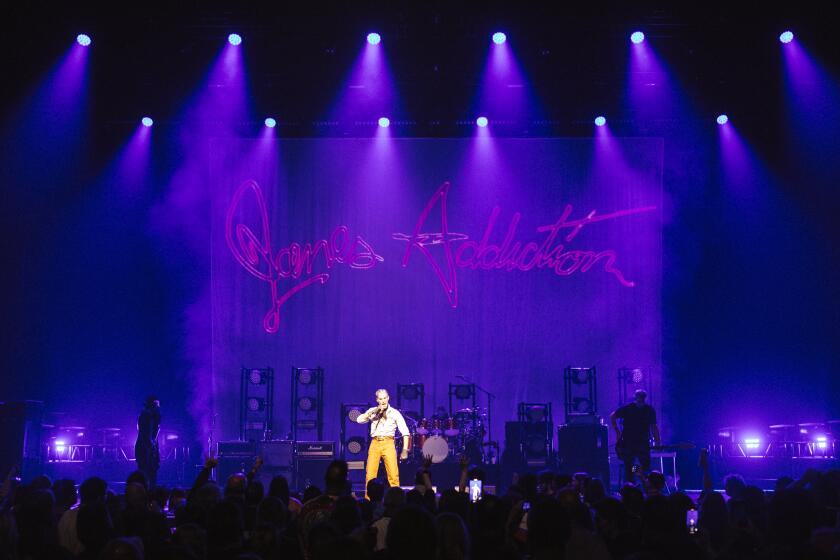Stars of Colombia’s past make new kinds of music on ‘Ondatrópica’
Two dozen near-forgotten veterans of Colombia’smusical golden age gathered earlier this year in a Medellín studio — the same place they made those old hits of the ‘60s and ‘70s. But this time around they were joined by younger artists and, co-directing the whole thing, a hipster English producer.
Amid the mix of old and new sounds were gaitas and champetas drawing on styles from Colombia’s Pacific and Atlantic coastal regions, beat-boxing by the youngest participant (percussionist Chongo, 25) and a first-time rap from its eldest (flutist Pedro “Ramayá” Beltrán, 82).
And then there was the cumbia version ofBlack Sabbath’s”Iron Man.”
It’s all on “Ondatrópica,” the new, two-CD set drawn from the sessions, and can be heard Sunday at the Mayan Theater in downtown L.A., when a dozen of the participants from the sessions perform.
But what’s perhaps most striking about Ondatrópica is that its mix and match of styles and eras is hardly an exercise in kitsch.
In fact, it’s quite possible to listen to “Iron Man” — here titled “I Ron Man” and sung in Spanish — without even realizing it’s the Sabbath song until a ways in. The groove is so strong, the performance so organic with its layers of percussion and horns, it sounds like something straight from these musicians’ own traditions.
“I just think it’s Colombian, isn’t it?” says Will Holland, the hipster Englishman, better known under his performing/producing name Quantic.
It might have been done with a little wink, Holland allows, but it is no gimmick. Rather, he says, it’s true to the progressive legacy of Discos Fuentes, the historic Colombian label and studio honored in this project.
“Otherwise it’s all these people living their lives as a gimmick,” he insists, on the eve of the touring group’s debut performances in London as part of pre-Olympics festivities. “It’s quite real.”
That was crucial to Holland, who’s made Colombia his home since 2006. He plays accordion with his band Combo Barbaro. Co-producer Mario Galeano, a Bogotá native, also fronts his own band, Frente Combiero.
The new touches, they say, fit the spirit of the classics from the Discos Fuentes catalog, one of the most creatively rich treasures of Latin American music.
Its roster sported the inventive architects and anchors of the era, many of whom are represented in Ondatrópica: Saxophonist Michi Sarmiento (who is also the son of Disco Fuentes’ top arranger from the ‘60s sessions), timbales master Wilson Viveros, star Pacific coast singer Markitos Micolta and innovative ‘70s bandleader Fruko among them.
“We have really studied deeply how things worked in the ‘50s, ‘60s and ‘70s,” says Galeano, 34. “Even though those things took place years ago, they were pretty progressive at the time. But today in Colombia a lot of people think this is grandparents’ music. We wanted to show the heavy things from that era was not different from the generation we have today.”
The whole thing was made possible through financial support from the British Council, the Colombia office of which had backed an earlier Galeano collaboration with Guyana-born dub star Mad Professor. The 40-odd musicians were flown to Medellín to record at the old Discos Fuentes studios, utilizing the facility’s analog tape equipment under the guidance of engineer Mario Rincon, another veteran of the classic sessions. Holland and Galeano meticulously wrote out the parts for both the old and new songs. Paramount was the comfort, and confidence, of the veterans.
“A lot of the people who hadn’t recorded for some time were worried we were inviting them to do a reggaeton or full-on rap thing, which they couldn’t do,” Holland says. “A lot were relieved when they came in and saw we had music on stands and microphones set up to have them all recording in the same room.”
Superficially, this might call to mind the Buena Vista Social Club, which brought “forgotten” Cuban stars and sounds back to the spotlight. But the producers hope people will see beyond that.
“Not knocking the Buena Vista Social Club, but we didn’t want to take a snapshot of the old guys,” Holland says. “We were interested in progressive arrangements, using new colors and textures.”
Adds Galeano, “We don’t want to be perceived like some museum or folkloric thing. We really wanted to show new ways, the strong side of this, how alive it is.”
Covering Black Sabbath might have taken care of that, though Holland insists that while many of the older musicians had never heard, or heard of, the metal group, it wasn’t a big stretch: Sabbath hails from the same part of England where he was born, and heavy metal has a strong foothold among Colombian youth.
There will be at least one point in the concerts that never could be mistaken for a Buena Vista knockoff, something perhaps even more seemingly incongruous than “I Ron Man.” It will come when octogenarian Ramayá will step forward and treat the audience to his rendition of Rod Stewart’s “Do Ya Think I’m Sexy.”
Out of place? Not at all.
“It’s a cover he did in the ‘70s,” Galeano explains. “So lots of people in Colombia heard his version. It was something that came really naturally in our first rehearsal days. He said, ‘Look, we have to play this song.’ And it worked.”
ALSO:
Plugged into Bob Dylan’s guitar
For Sunset Boulevard, a new dawn
Ice-T speaks out against gun control
More to Read
The biggest entertainment stories
Get our big stories about Hollywood, film, television, music, arts, culture and more right in your inbox as soon as they publish.
You may occasionally receive promotional content from the Los Angeles Times.










